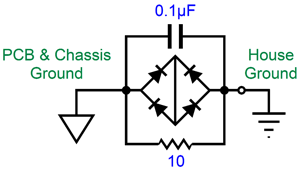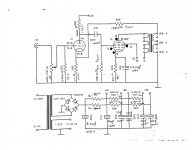Hello all! Hope everyone is doing well amidst this chaos...
I've been building an enclosure for my tube amp and ran into some contradictory information regarding chassis grounding, so I figured I'd ask the experts.
My enclosure has a wooden frame with a couple of sheet metal (zinc) plates for the top (where the sockets are) and the back panel (where all the audio connectors are). From what I have read, it is common for these metal chassis plates to be attached to the earth connection on a 3-prong cable. I just want to be sure that I won't be introducing additional noise or the possibility of an electrified chassis by attaching the ground side of the amplifier to earth.
I attached the schematic below. Thank you for any and all help!
I've been building an enclosure for my tube amp and ran into some contradictory information regarding chassis grounding, so I figured I'd ask the experts.
My enclosure has a wooden frame with a couple of sheet metal (zinc) plates for the top (where the sockets are) and the back panel (where all the audio connectors are). From what I have read, it is common for these metal chassis plates to be attached to the earth connection on a 3-prong cable. I just want to be sure that I won't be introducing additional noise or the possibility of an electrified chassis by attaching the ground side of the amplifier to earth.
I attached the schematic below. Thank you for any and all help!
Attachments
Connecting the chassies to ground ( 3-rd connector ) is the safest solution.Hello all! Hope everyone is doing well amidst this chaos...
I've been building an enclosure for my tube amp and ran into some contradictory information regarding chassis grounding, so I figured I'd ask the experts.
My enclosure has a wooden frame with a couple of sheet metal (zinc) plates for the top (where the sockets are) and the back panel (where all the audio connectors are). From what I have read, it is common for these metal chassis plates to be attached to the earth connection on a 3-prong cable. I just want to be sure that I won't be introducing additional noise or the possibility of an electrified chassis by attaching the ground side of the amplifier to earth.
I attached the schematic below. Thank you for any and all help!
BUT do not ever connect chassies to any of the mains leads, even if one is
ground at your place, moving the amp will create a death trap.
Yes, ground loops may be introduced, but that is helped by grounding other
stuff too, and possibly loosening the signal ground <> chassies ground.
A small resistor of 100 ohm might do wonders !
So, what you're saying is connect both panels to earth and run a 100 ohm resistor from signal ground to earth?
Sorry for misunderstanding, but thank you for the response!
Sorry for misunderstanding, but thank you for the response!
If hum problems occur when connecting other equipment then separating
signal ground and chassies ground might be reducing hum.
But all panels on one amp should be connected together and grounded.
signal ground and chassies ground might be reducing hum.
But all panels on one amp should be connected together and grounded.
Zinc plates, how did you end up with that?
For multiple plates and wood sides, get everything mounted together and use your meter to be sure that the plates show continuity to each other. You may find using some steel L-brackets between the plates will help with this.
For earthing, where your wall power comes into the amp, connect the earth wire to the chassis as close as is reasonably possible to where the mains enters the chassis.
For your audio ground, you want the entire ground (bus or star) to only connect to the chassis in one spot. You may find it very helpful to use a resistor between audio ground and the chassis, or a pair of antiphase diodes with a 0.1uF ceramic cap across them, or all four.
For multiple plates and wood sides, get everything mounted together and use your meter to be sure that the plates show continuity to each other. You may find using some steel L-brackets between the plates will help with this.
For earthing, where your wall power comes into the amp, connect the earth wire to the chassis as close as is reasonably possible to where the mains enters the chassis.
For your audio ground, you want the entire ground (bus or star) to only connect to the chassis in one spot. You may find it very helpful to use a resistor between audio ground and the chassis, or a pair of antiphase diodes with a 0.1uF ceramic cap across them, or all four.
Thank you all for the helpful replies. I will:
-Connect both chassis panels and ensure there is continuity between them
-Connect earth to the chassis panel as soon as it comes in from the mains
-Connect the audio ground to the chassis ground in one location with a 100 ohm resistor in between
The Zinc plates were were the only ones in stock at the hardware store when I went to do some last minute project shopping before my state went into lockdown.
Thanks once again!
-Connect both chassis panels and ensure there is continuity between them
-Connect earth to the chassis panel as soon as it comes in from the mains
-Connect the audio ground to the chassis ground in one location with a 100 ohm resistor in between
The Zinc plates were were the only ones in stock at the hardware store when I went to do some last minute project shopping before my state went into lockdown.
Thanks once again!
Only use a resistor is you encounter hum and need a solution (which this may provide).
I tie Earth (house ground) to the chassis at the IEC connector, Signal ground to chassis at the RCA jacks, and heater/b+ return (power ground) to the chassis (like in the 1950's...) and have no hum whatsoever.
The usual trick though is 10R || with anti-parallel diodes like this:

Another trick to solve hum is to plug all your audio stuff into a power strip, with the heaviest loads connected to the end closer to the wall cord.
In the case of my TV, I couple it to the system through TOSlink because it's on a circuit on the other phase and connecting the television tot he computer through the HDMI cable makes a ground loop with the audio system. The computer is connected by coax SP DIF, too.
I tie Earth (house ground) to the chassis at the IEC connector, Signal ground to chassis at the RCA jacks, and heater/b+ return (power ground) to the chassis (like in the 1950's...) and have no hum whatsoever.
The usual trick though is 10R || with anti-parallel diodes like this:

Another trick to solve hum is to plug all your audio stuff into a power strip, with the heaviest loads connected to the end closer to the wall cord.
In the case of my TV, I couple it to the system through TOSlink because it's on a circuit on the other phase and connecting the television tot he computer through the HDMI cable makes a ground loop with the audio system. The computer is connected by coax SP DIF, too.
- Home
- Amplifiers
- Tubes / Valves
- Chassis Grounding Question
